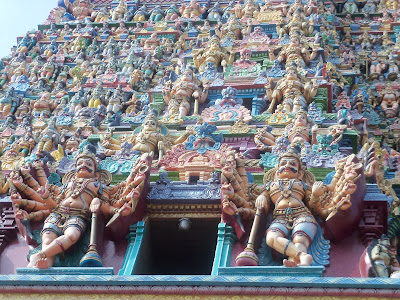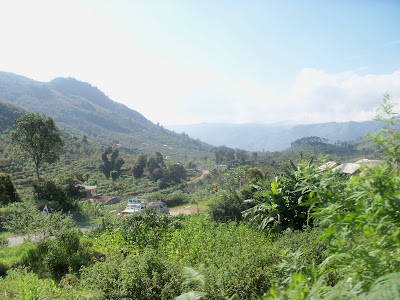Although the temple was gorgeous to see, what I found most interesting was the devotion that the visiting Hindus showed at the temple. They were praying, bringing gifts of coconuts and other fruits for the gods, the men were putting white powder on their foreheads to show their devotion, and many of the women were getting their heads shaved for that same purpose. I am not a religious person myself, and so seeing these people be so enthralled to be in this spiritual place, and seeing the pure devotion on their faces as they knelt and prayed to their gods, was something quite unique and interesting for me.
I also went inside the temple and got blessed by an elephant. You put a coin in his trunk and he taps your head as a sign of being blessed. I also got a picture with the elephant's trunk on my head. His trunk was dripping snot though, and it got in my hair and was running down my face. Ewwwww!!!
There were also some unpleasant parts of the Madurai experience. There are tons of beggars and street vendors that hang out around the temple, hoping to get some money from the "rich foreigners". As a white young woman, I was the perfect target for these people, most of whom are selling jewelery and purses. They followed me around constantly, and no matter how many times, and in how many ways I told them to take a hike, they refused to listen and continued to follow me, begging for me to buy their stuff. At any given time, I was being followed by around 5 vendors/beggars hoping for money. There were also the Kashmiri shop owners who would come up to me, pretending to be tour guides, saying that they could show me the best view of the temple. If you followed them, they'd just take you into their cloth shops and try to sell you their stuff. I had been told about them before going to Madurai, so i didn't fall for their scams.
There was one incidence though that really pulled at my heart strings. I bought a necklace from one of the street vendors, which turned out to be a terrible idea. There must be beggars who sit there watching for people who are willing to take out their wallet. So as soon as I finished buying the necklace, a mother signaled to her 5 young children, who all stood up and began to jump around me begging for money. It was just sad that these children had to beg at such a young age. You just have to learn here that you can't give money to all of the beggars. If I have coins (1-5 rupees) I will give them to beggars, which is pretty standard. But if I started giving 10 or more rupee bills to the beggars, then I am just promoting the idea that all white people are rich and willing to give lots of money. This is a system that Vera and George taught me, and it seems sensible.
Here are some pictures:
 |
| Temple statues with 8-armed people. |
 |
| Called an auto-rickshaw, this is a fun way to travel around the city. Its like a mini taxi. |
 |
| Getting snotted on by the elephant. |
 |


































